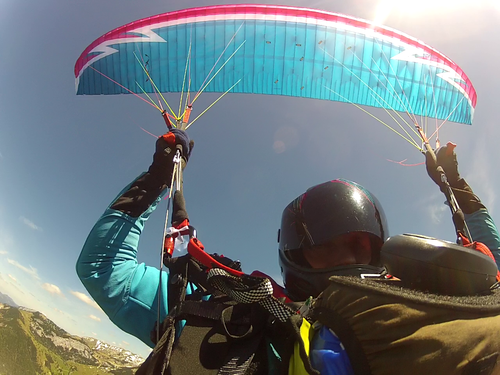Mentor 3 M |
|||||||||||||||||||||||||||||||||||||||||||||||||||||||||||||||||||||||||||||||||||||||||||||||||||||||||||||||||||||||||


|
|||||||||||||||||||||||||||||||||||||||||||||||||||||||||||||||||||||||||||||||||||||||||||||||||||||||||||||||||||||||||
Instability rating |
|||||||||||||||||||||||||||||||||||||||||||||||||||||||||||||||||||||||||||||||||||||||||||||||||||||||||||||||||||||||||
|
|||||||||||||||||||||||||||||||||||||||||||||||||||||||||||||||||||||||||||||||||||||||||||||||||||||||||||||||||||||||||
Glider characteristics |
|||||||||||||||||||||||||||||||||||||||||||||||||||||||||||||||||||||||||||||||||||||||||||||||||||||||||||||||||||||||||
|
Launch preparations: average
launch characteristics: balanced, climbs constantly, no guidance necessary, good feedback during inflation, moderate braking required, control check simple, low takeoff speed
asymmetric collapse: canopy colllapses at high angle to leading edge, high dynamics, total course change >360°, (5), fast course change rate, marked forward pitching 60-75°, (4), very high height loss 50-59 m, (4), high sink velocity 20-24 m/s, (3), collapse on opposite wingtip with course change <90°, (4), G-Force < 2,5 G, (1)
Frontal collapse: canopy collapses with high total collapse aera, marked pitch backwards 45-60°, marked pitch forwards 45-60°, high dynamics, course change <90°, (2), recovery usually immediate, asymmetric recovery, immediate return to normal airspeed, high height loss 40-49 m, (3), low sink velocity 10-14 m/s, (1)
Spiral dives: rapid sink velocity increase, Moderate G-Force 3,5- 4.0 G, (2), Sink velocity after 720° <18 m/s, (3), High maximum sink velocity < 22 m/s, (3), sink velocity increase < 6 m/s on brake release, (2), Course change 360-540° after spiral exit, (3), high height loss during recovery 60-100 m, (3)
B-Stall: normal force required, unstable sink phase, canopy deforms to horseshoe
big ears: simple initiation, wingtips flatter markedly, delayed automatic recovery, Vsink unaccelerated 2,5-3 m/s, Vsink accelerated 3-3,5 m/s, Vunaccelerated 3-5 km/h less than trimspeed, Vaccelerated 5-8 km/h faster than trimspeed |
|||||||||||||||||||||||||||||||||||||||||||||||||||||||||||||||||||||||||||||||||||||||||||||||||||||||||||||||||||||||||
Notes |
|||||||||||||||||||||||||||||||||||||||||||||||||||||||||||||||||||||||||||||||||||||||||||||||||||||||||||||||||||||||||
|
Launch preparations: Nova's Mentor 3 had only one weak point: the rear riser is so long that it tends to wrap and twist a little. Its red coloured unsheathed upper gallery lines are relatively easy to sort and check. Launch characteristic: Nova's Mentor 3 has good balanced launch characteristics: moderate climb to the zenith with good internal pressure and only moderate use of the brakes required to stabilise at the zenith. Asymmetric Collapse: We compared Nova's Mentor 3 with values recorded in our first serial test series in 2012 from the Mentor 2.Height loss on collapsing is somewhat reduced and we noted no tendencies to cravat on the newer model. The canopy turns through a 180° with high sink rates after self recovering after an assymetric collapse. Massive collapses increased reaction dynamics markedly and caused major cascade collapses on the opposite wing side. Front collapses: Nova's Mentor 3 performs better in front collapse testing than earlier models. Recovery is #immediate and mostly symetrical, even massive collapses did not indicate any tendency of the glider entering a stable front stall but recovery became less predictable and sometimes assymetric. Spiral Dive: More time to recover is needed by the Mentor3, the glider turns through a further 360° with a high sink rate on release of the inner brake before beginning self recovery. B-Stall: On the Mentor 3 this behaviour occurs even faster, and the glider handbook makes a clear statement about it. For both gliders it is better to cross the B-stall off the list of flyable descent manoeuvers. Big Ears: Mentor 3 tend to flap their ears, but this does not provoke roll or yaw movements. |
|||||||||||||||||||||||||||||||||||||||||||||||||||||||||||||||||||||||||||||||||||||||||||||||||||||||||||||||||||||||||
Rating |
|||||||||||||||||||||||||||||||||||||||||||||||||||||||||||||||||||||||||||||||||||||||||||||||||||||||||||||||||||||||||
|
Safety class 5 This class of paraglider reacts very demandingly to one or more of the following manoeuvres: frontal collapse, asymmetric collapse or spiral dive and may present pilots with a particular challenge.Very demandingly means that the above manoeuvres result in highly dynamic reactions from the glider, and/or large height losses. Critical subsequent glider reactions are also to be expected. Expert piloting skills achieved through constant practice, fast personal reaction times and precise pilot inputs are required to be able to immediately react to the above manoeuvres to maintain flight control and prevent large height loss or subsequent critical glider reactions. In particular, pilots should be able to recognise the onset of the above manoeuvres and be able to prevent or minimise their effects through immediate and precise pilot inputs. |
|||||||||||||||||||||||||||||||||||||||||||||||||||||||||||||||||||||||||||||||||||||||||||||||||||||||||||||||||||||||||

